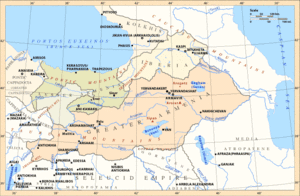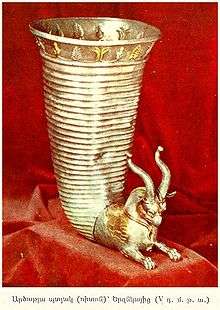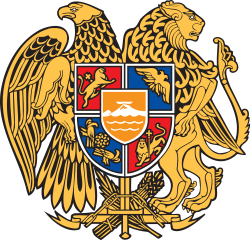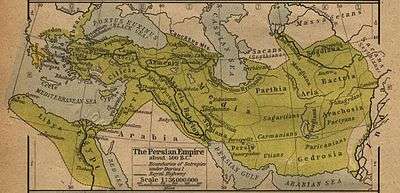Satrapy of Armenia
| Satrapy of Armenia | ||||||||||||||||||
| Սատրապական Հայաստան Satrapakan Hayastan | ||||||||||||||||||
| Satrapy | ||||||||||||||||||
| ||||||||||||||||||
 Territory of the Orontid Dynasty in IV-II BC | ||||||||||||||||||
| Capital | Tushpa Erebuni | |||||||||||||||||
| Languages | Armenian | |||||||||||||||||
| Religion | Paganism, Zoroastrianism | |||||||||||||||||
| Government | Monarchy | |||||||||||||||||
| King | Orontes I (first) Hydarnes (last) | |||||||||||||||||
| Historical era | Ancient | |||||||||||||||||
| • | Established | 522 BC | ||||||||||||||||
| • | Disestablished | 331 BC | ||||||||||||||||
| ||||||||||||||||||
| Today part of | | |||||||||||||||||
| Warning: Value specified for "continent" does not comply | ||||||||||||||||||
The Satrapy of Armenia (Armenian: Սատրապական Հայաստան Satrapakan Hayastan; Old Persian: Armina or Arminiya), a region controlled by the Orontid Dynasty (570-201 BC) (Armenian: Երվանդունիներ Yervanduniner) was one of the satrapies of the Achaemenid Empire in the 6th century BC, which later became an independent kingdom. Its capitals were Tushpa and later Erebuni.
History
Origins
After the collapse of the Kingdom of Urartu (Ararat), the region was placed under the administration of the Median Empire and the Scythians. Later the territory was conquered by the Achaemenid Empire, which incorporated it as a satrapy, and thus named it the land of "Armina" (in Old Persian; "Harminuya" in Elamite; "Urashtu" in Babylonian)).

Orontid Dynasty
The Orontid Dynasty, or known by their native name, Eruandid or Yervanduni, was a hereditary dynasty of ancient Armenia, and the rulers of the successor state to the Iron Age kingdom of Urartu (Ararat).[1][2][3] Historians state that the dynasty was of Iranian origin,[4][5][6][7][8] and suggest, albeit not clearly, that it held dynastic familial linkages to the ruling Achaemenid dynasty.[9] Throughout their existence, the Orontids stressed their lineage from the Achaemenids in order to strengthen their political legitimacy.[10]
Members of the dynasty ruled Armenia intermittently during the period spanning from the 6th to at least the 2nd centuries BC, first as client kings or satraps of the Median and Achaemenid empires and later, after the collapse of the Achaemenid empire, as rulers of an independent kingdom, and later as kings of Sophene and Commagene, which eventually succumbed to the Roman Empire.
The Orontids established their supremacy over Armenia around the time of the Scythian and Median invasion in the 6th century BC.[11] Its founder was Orontes I Sakavakyats (Armenian: Երվանդ Ա Սակավակյաց, Yervand I Sakavakyats). His son, Tigranes Orontid, united his forces with Cyrus the Great and killed Media's king. Moses of Chorene called him "the wisest, most powerful and bravest of Armenian kings."
From 553 BC to 521 BC, Armenia was a subject kingdom of the Achaemenid Empire, but when Darius I was king, he decided to conquer Armenia. He sent an Armenian named Dâdarši to stop a revolt against Persian rule, later replacing him with the Persian general, Vaumisa, who defeated the Armenians in 521 BC. Around the same time, another Armenian by the name of Arakha, son of Haldita, claimed to be the son of the last king of Babylon, Nabonidus, and renamed himself Nebuchadnezzar IV. His rebellion was short lived and was suppressed by Intaphrenes, Darius' bow carrier.
After the Battle of Gaugamela (331 BC), Orontes III was able to regain independence for Armenia. But in 201 BC, Armenia was conquered by Artashes, a general from the Seleucid Empire, and also said to be a member of Orontid dynasty. The last Orontid king Orontes IV was killed, but the Orontids continued to rule in Sophene and Commagene until the 1st century BC.
In two inscriptions of king Antiochus I of Commagene on his monument at Mount Nemrut, Orontes I (son of Artasouras and husband of Artaxerxes' daughter Rhodogoune), is reckoned as an ancestor of the Orontids ruling over Commagene, who traced back their family to Darius the Great.

See also
Notes
- ↑ Toumanoff, Cyril (1963). Studies in Christian Caucasian history. Washington D.C.: Georgetown University Press. pp. 278ff.
- ↑ (Armenian) Tiratsyan, Gevorg. «Երվանդունիներ» (Yerevanduniner). Armenian Soviet Encyclopedia. vol. iii. Yerevan: Armenian Academy of Sciences, 1977, p. 640.
- ↑ Krause, Todd B. and John A.C. Greppin, and Jonathan Slocum. "The Yervanduni Dynasty." The A. Richard Diebold Center for Indo-European Language and Culture at the University of Texas. Jan. 22, 2009.
- ↑ Garsoïan, Nina (1997). "The Emergence of Armenia" in The Armenian People from Ancient to Modern Times, Volume I, The Dynastic Periods: From Antiquity to the Fourteenth Century. Richard G. Hovannisian (ed.) New York: St. Martin's Press, pp. 46-47. ISBN 0-312-10169-4.
- ↑ Babaie, Sussan; Grigor, Talinn (2015). Persian Kingship and Architecture: Strategies of Power in Iran from the Achaemenids to the Pahlavis. I.B.Tauris. p. 80. ISBN 978-1848857513.
Iranian culture deeply influenced Armenia, and Iranian dynasties ruled Armenia during several important periods, including the Orontids (c. sixth century - c. early second century BCE) and Arsacids (54-428 CE).
- ↑ Garsoian, N. (2005). "TIGRAN II". Encyclopaedia Iranica.
Tigran (Tigranes) II was the most distinguished member of the so-called Artašēsid/Artaxiad dynasty, which has now been identified as a branch of the earlier Eruandid [Orontid] dynasty of Iranian origin attested as ruling in Armenia from at least the 5th century B.C.E
- ↑ Allsen, Thomas T. (2011). The Royal Hunt in Eurasian History. University of Pennsylvania Press. p. 37. ISBN 978-0812201079.
- ↑ Sartre, Maurice (2005). The Middle East Under Rome. Harvard University Press. p. 23. ISBN 978-0674016835.
- ↑ Payaslian, Simon (2007). The history of Armenia : from the origins to the present (1st ed.). New York: Palgrave Macmillan. p. 8. ISBN 1403974675.
Although the origins of the Ervanduni [Orontid] family is not clear, historians suggest dynastic familial linkages to the ruling Achaemenid dynasty in Persia.
- ↑ Payaslian, Simon (2007). The history of Armenia : from the origins to the present (1st ed.). New York: Palgrave Macmillan. p. 8. ISBN 1403974675.
The Ervandunis certainly stressed their Achaemenian lineage to strengthen their political legitimacy.
- ↑ Tiratsyan, Gevork. «Երվանդունիներ» (Yerevanduniner). Soviet Armenian Encyclopedia. vol. iii. Yerevan, Armenian SSR: Armenian Academy of Sciences, 1977, p. 640.


